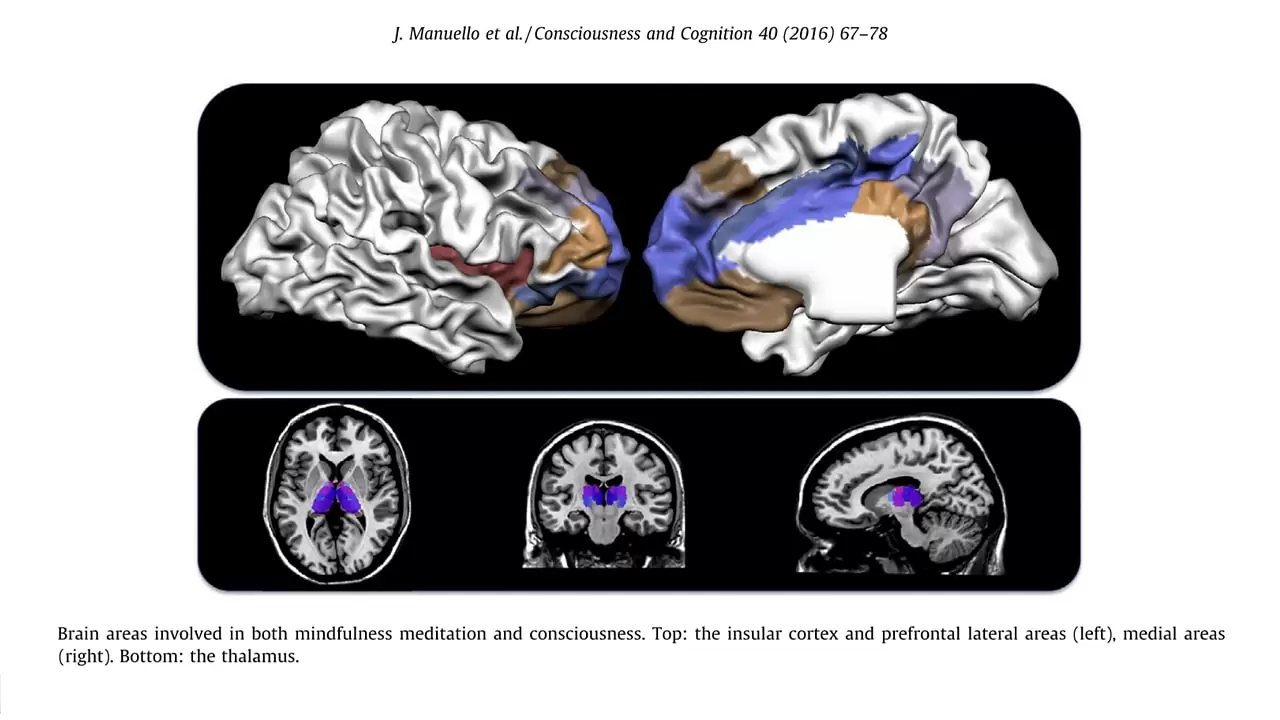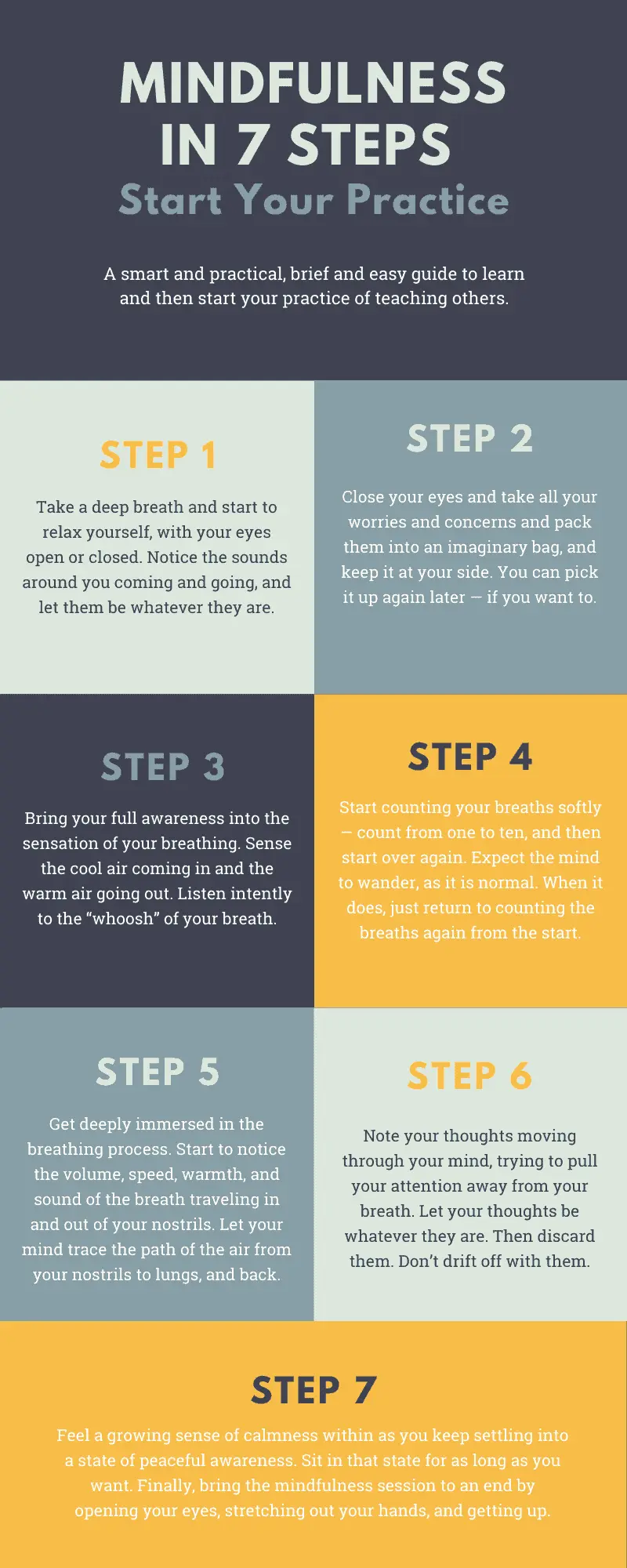— Researched and reviewed by Dr. Sandip Roy.
If you’ve been toying with the idea of starting mindfulness meditation, this is it. This 7-Step Mindfulness Meditation Guide is a practical manual specifically made for beginners. So even if you have zero experience, you will learn to meditate mindfully.
Mindfulness is an intense awareness of the happenings in the present moment. It’s backed by solid science, as mindfulness is one of the most researched areas in positive psychology.
When you’re mindful, you are sharply aware of your thoughts and emotions as they appear. It is not a state of thoughtlessness.
A state of mindfulness allows you to notice your sensations, thoughts, feelings, and happenings around you, taking place right now, away from both the future and the past.
We can be mindful in many ways, like mindful breathing, mindful walking, and mindful eating. However, the best way to draw its maximum benefits is through mindfulness meditation (this guide).
[Download the free “Mindfulness Meditation Guide PDF” (link at the end) to launch your practice. You will be ready to start mini-workshops to teach others after 6–8 weeks of self-practice.]
“Be happy in the moment, that’s enough. Each moment is all we need, not more.” ― Mother Teresa
Learn how to do so in this step-by-step guide:
7-Step Beginner Guide To Mindfulness Meditation

1: Breathe in deeply, and breathe out slowly, letting yourself relax.
Take a deep breath, hold it for a moment, and then breathe out. Close your eyes gently. Keep taking deep breaths and releasing them, and feel yourself getting relaxed more and more.
Now, notice as many sounds around you as you can, but one by one.
Pick out one sound and become curious about it. Let it come to you clearly. Explore the sound for a while. Then let it go, as if the sound vanished from your attention.
It might be hard at first. It helps if you imagine it fading away and out, like someone carrying off a small bell into the distance.
Tell yourself you are giving up your control over the source of the sound and letting it go. You are releasing it to leave you and go wherever it wants.
As you pull your attention away from the first sound, spend the next few seconds finding another sound. Then do the same with it.
If a dog is barking nearby, listen to it for a while. Then let go of it. Let it be whatever it is. Next, find another sound: the rhythmic beating of your heart.
This is the first step in your mindfulness meditation. You could practice this step at any time without going into full meditation.
You do not have to do anything else other than to be aware and let go of the sounds around, one by one. It gets easier after a few dry runs.
If your mind wanders away with one of those sounds, tell it you have noticed it. If the whirring of a distant motorboat makes you imagine what people do on a yacht parked mid-sea, then gently ask it to focus on a different sound.
All along, keep taking in and releasing slow and deep breaths.
[Learn how to relax by ➜ stimulating your vagus nerve.]
2: Gently ask your mind to keep aside all your worries and concerns.
Drop all your concerns now, like setting down a heavy bag.
The biggest issues of mindfulness practice are the thoughts and worries taking our attention away from the present moment. However, once you recognize that a mind cannot exist without thinking, it stops being an issue.
Then your task is to unhook yourself from your intrusive thoughts. Here’s how to do it.
Take all your worries and concerns and pack them into an imaginary bag. Then keep that bag at your side, telling yourself you are not throwing them away, but keeping them down for a few minutes.
If your worries sit on your shoulders so much of the time that they are a part of you, it may be difficult for you to off-load them. But assure yourself you can pick up the bag again after your meditation session — if you’d like to.
This imaginary act will remove a big load off your shoulders and mind, and make you feel lighter. It would let you realize you are allowing yourself this little time to move away from worldly worries.
3: Bring more awareness into breathing, feeling it with your senses.
Now focus more on your breath. Bring your full awareness to the sensation of your breathing.
Feel the cool air coming in, and the warm air going out. Try “tasting” the air—is it dry, salty, fresh?
Listen intently to the “whoosh” of your breath each time it comes in and goes out. Feel the chest rising and falling, and the belly expanding and contracting. Notice the volume, speed, warmth, and sound of the breath traveling in and out of your nostrils.
Let your mind trace the path of the air from your nostrils to your windpipe. Let your mind trace the path of the air from your nostrils to your windpipe. And from there on to the small air sacs in your lungs called alveoli.
Wait for a few seconds as the blood around your lungs absorbs the oxygen from the breath and gives off carbon dioxide (CO2). Then retrace the CO2-laden air from the lungs back out through the nose.
Do not control your breath; let it behave however it wants, flowing in and out on its own. Your job at this step is to be aware of the air movement between your nose and lungs.
Once your mind settles down during the first few minutes, you will find it easier to focus your attention on the in-breath as it travels deeper, into your lungs, and out again.
With each inspiration, tell your mind you are breathing in swigs of calmness and relaxation. With each expiration, tell yourself you are breathing out the stresses and anxieties.
4: Start counting your breaths slowly. Bring your mind back if it wanders.
Start counting your breaths softly — count from 1 to 50, take a slight pause, and then start over from 1.
This is a difficult step since our monkey mind can’t seem to stay focused on one thing (like, counting the breaths to 50).
So, the main task is to take notice that your mind has veered off from the counting process. Whenever you realize your mind is thinking something else, gently tell it, “Let’s get back to counting the breaths.”
Suppose you discover your mind has strayed off to thinking about something you need to do tomorrow before you reached 50, don’t be annoyed. Simply smile at your mind’s wanderlust and start back from 1.
Expect the mind to wander; it is normal. When it does, simply return to counting your breaths again from the start. Be gentle with yourself, letting go of all self-criticism.
Mindfulness is not about succeeding or failing. It is also not about achieving perfection. It is rather about a sincere attempt to tame your monkey mind into focusing on the detailed process of breathing.
While on it, why do we focus on the breath? Because it is always with us, and we could practice being mindful of breath-awareness at any place we are.
Each time you notice your mind has wandered off, tell yourself:
I notice my thoughts, but I choose not to let them carry me away. When I notice my mind is not where I want it to be, I gently ask it to return.
Try not to get caught up or fascinated with them, so you do not start thinking yourself away. But also, don’t struggle to push those off your mind. The idea is to sit with your thoughts and let them be whatever they are.
Most of all, just notice their impermanence as they finally fade off. Your thoughts will ultimately go away, so the best thing you can do is have an attitude of acceptance toward them.
Think of the thoughts arriving in your mind as fluffy bits of cloud. Let them flow across your mind’s sky. Don’t throw an imaginary rope around one and hang on it. Watch the clouds, let them drift away, but do not flow far away with them.
Mindfulness asks you to explore the present moment with curiosity, but without judgment.
Each time you catch yourself being dragged away by a thought, gently bring back your focus to your breath—again and again. As soon as you notice your mind has left the present moment, gently pull it back to your breath—again and again. The more you practice, the better you become at this.
▪ You cannot fail at mindfulness. Every time you find your awareness has drifted away from your breath, it only proves you are still mindful.
▪ Since you noticed your mind wandering away from your breath, it means you are present and mindful of it. Noticing your mind has wandered off is only a sign you have to bring it back, not a failure.
▪ Finding where your mind goes and telling it you know where it is now, is being in mindfulness. You cannot fail at it.

5: Get immersed in the present, losing consciousness of your surroundings.
Immerse yourself more and more in the present moment. Open your entire consciousness to the unfolding experience of the present moment.
This is the crucial stage in which you lose awareness of your surroundings and become semi-conscious. You become so relaxed that your body feels lighter, your mind relieved and even ecstatic, and you lose track of everything but the awareness of your being.
This is the stage of stabilizing the mindfulness state into a state of Mindful Presence.
Mindfulness and consciousness are inextricably intertwined concepts. Things in our consciousness can come from external (environment) or internal (thoughts, emotions, intentions, memories, and sensations) inputs.
When we eliminate external awareness in mindfulness, we allow the rise of the mindful presence. Also called conscious presence, it is defined as “the subjective sense of the reality of the world and of the self within the world” (Seth, et al., 2012).
At this point, your mindfulness state gets stabilized and evolves into pure awareness. This is the state of mindful presence. As this presence grows, so does your sense of being.
You are being being. Doing and having no longer contain little moments of being; instead, being is increasingly the ongoing space through which ripples of doing and having come and go. — Rick Hanson. Ph.D.
Actually, this is a stage when you don’t have much to do; most of this stage happens on its own.
When you notice the emergence of mindful presence, your goal is to hold on to it without letting your mind drift. It’s a fleeting experience at first, and it’s gone before you can truly appreciate it. It becomes longer with practice.
The brain areas thought to be involved in conscious presence are the orbitofrontal cortex, the anterior cingulate cortex, and the insula (Critchley et al., 2004; Seth et al., 2012).

6: Accept the thoughts and emotions moving across your mind just as they are.
This step is perhaps the most important one in your practice of mindfulness meditation. It involves understanding yourself and accepting your thoughts and emotions.
Acceptance is a key attitude in mindfulness meditation. It can relieve us of many burdens, such as shame and regret. Remember, mindful presence is a necessary precondition for acceptance and self-awareness.
Acceptance in mindfulness is trying to see the situation as it is now, and allowing your thoughts and feelings to “be” just as they are, without adding your interpretations.
Acceptance is an active state. So, open yourself up and make room for the thoughts, feelings, and sensations, whether painful, pleasant, or neutral, that pass through your mind.
Acceptance begins with acknowledging your discomfort and suffering. You can’t move on from where you are if you don’t acknowledge where you are and what is currently happening.
Once you have acknowledged your current situation or your painful past, label the emotion it brings. Like, “I’m feeling angry presently.”
Then, be curious about it and inquire, “Where did this feeling come from? Where am I feeling it?”
Then, relax that part where the feeling hurts, and release it, “I have accepted it and I now release it.”
If you see a beautiful cow standing at your door, you know it won’t be there forever. You accept its presence but do not accompany it.
Similarly, let yourself accept and embrace your thoughts and feelings, wishes and plans, imaginations and memories that arise in your mind.
7: Stay in your state of peaceful awareness before exiting the session.
Feel a growing sense of peaceful awareness within as you keep settling into a state of non-doing.
Russ Harris, an internationally acclaimed Acceptance and Commitment Therapy trainer and author of the world’s best-selling ACT book, says:
Self-acceptance trumps self-esteem. True success is living by your values. Hold your values lightly, but pursue them vigorously. Don’t obsess about the outcome; get passionate about the process.
In this final stage, let the moments pass by and notice how it feels not to do anything apart from sitting there in a state of peaceful awareness.
Once you are there in a state of peaceful awareness, continue being in that state as long as you want.
Finally, you may bring the mindfulness session to an end by opening your eyes, stretching out your hands, and getting up.
“Few of us ever live in the present. We are forever anticipating what is to come or remembering what has gone.” ― Louis L’Amour
Infographic: A Beginner’s Guide To Mindfulness Steps

Five Tips For Beginners at Mindfulness
Top Tip: Record the steps on your phone in your voice.
1. Read and Record: Reading the whole post should not take you more than 10 minutes. Once you are through, re-read the steps and record them in your voice. Listening in your own voice helps you concentrate and understand the entire process better. Later, you will find it easy to explain to others.
2. Place and Posture: Find a comfortable place where you can focus and will not get disturbed or interrupted. You may sit on a chair, or a cushion on the floor, or lie down on a yoga mat. Place yourself in a posture that is both relaxed and alert, with your back reasonably straight if sitting.
3. Timing: Decide how long you’re going to dedicate. Set a timer. You can meditate as short or as long as you like. Start with shorter periods, around 5-10 minutes.
4. Regularity: It may not come to you effortlessly at first. Rest assured: with a little patience and practice, you will soon be good at following the steps. Another thing: do not postpone it until tomorrow, or even later today. And do it regularly. Do you realize 10 minutes of 24 hours is only 0.7% of your day?
5. Do It Today: Give it an honest attempt today. Better, try it as soon as you finish reading this. It will give you a head-start. Your first shot might be a little shaky and imperfect, but you would be one practice ahead. So, soon after you have gone through this guide, find a comfortable place that has minimum distractions, and follow these seven simple steps.
Why does focus on breathing matter in mindfulness meditation?
A crucial process accounting for mindfulness meditation is Interoceptive Attention (IA), which is our ability to recognize and analyze internal bodily sensations, like digestion, blood circulation, and breathing. IA in mindfulness practice increases functional neuroplasticity in the medial and anterior insula of the brain, areas that are linked to the awareness of the present moment (Craig, 2009).
Mindfulness-Based Stress Reduction (MBSR) training has been shown to significantly help people with social anxiety regulate their negative emotions. The authors suggest the most likely reason for this effect to be the functional integration of various brain networks during physical, attentional, and cognitive control (Goldin, et al., 2013).
Final Words
Meditation comes to us from Eastern culture and spirituality. The ancient scriptures of Hinduism, the Indian religion, contain the earliest mentions of this practice, while Buddhism, the philosophy of the prince-turned-sage Gautama Buddha, integrates meditation as its key element (Siegel, Germer, & Olendzki, 2008).
The goals of mindfulness practice are to become more aware of one’s own mental processes, focus on the work at hand, become flexible, recognize our biases and judgments, and respond with compassion.
Download a rich PDF of this guide (Right-click and Save the link.)
We suggest you read through this whole post first to get a fair idea of the steps. Then record them on your phone in your own voice, right away (you can do a better recording next time). Let it play when you start your first session of 7-Step Mindfulness meditation.
Take a look at this short video introducing a basic understanding of mindfulness, by Mellissa O’Brien:
Now that you know the 7 steps of mindfulness meditation, begin today. It is time to invite peace into your daily life. Do yourself a no-cost, high-value favor with a mere 10-minute mindfulness practice.
So start your self-practice today. Prepare yourself in the coming weeks to set up a place to hold mini-workshops and teach others this easy and effective method.
Don’t wait until tomorrow to make your move. Even if you’re considering doing it at another time, remind yourself you already know how to do it. You have your breath with you, so why not do it now?
√ Please share it with someone if you found this helpful.
√ Also Read: 20 Most Practical Mindful Eating Techniques (PDF)
• Our Story!